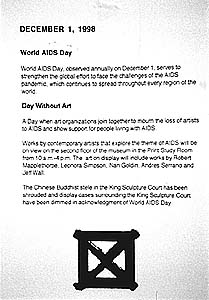

While at first glance this year's Day without Art may have seemed to be an Event Without Notice on campus, this is mainly due to the student body's lack of involvement. Happily the Allen Memorial Art Museum did put together an excellent exhibit to honor the day which is meant to attract attention to the world's AIDS crisis. Stephan Jost, assistant curator of western art at the museum, pulled a number of pieces from the collection to display in this exhibit. The artwork was diverse, focusing mainly on photography, and was augmented by several books which were checked out of the art library and left on the surrounding tables for visitors' perusal.

The more abstract black and white work of Robert Mapplethorpe next to the very graphic comic strip-style images done by David Wojnarowicz, both of whom died of AIDS-related complications, served as a strong beginning to a very emotionally charged collection. While their work is very different, they are similar in that they are artists who fought to push the boundaries of the definition of art.
Nan Goldin's photographs stood as a third contrast to their work. Goldin's portraits of typically marginalized people were strong and powerful, especially in this context. She attacks society's ideas of what is acceptable with her representation of drag queens and, in one photograph, of herself after she has been beaten.
Spread on an adjacent table was the museum's copy of "In a Dream You Saw a Way to Survive and You Were Full of Joy." This collection of photographs composed by prominent artists to raise money for AIDS research is very diverse. Its purchase allowed the AMAM to support an important cause while acquiring several excellent artworks. Work ranging from a portrait of a coal miner to a still life of a dead child to a picture of stars at night are included in this portfolio. Artists ranging from Jeff Wall, who takes very staged photographs, to Andres Serrano, who contributed a close-up of his wife's menstrual blood, were included.
Many of these artists have battled the National Endowment for the Arts at one time or another due to the organization's restriction of funding from art which does not meet their approval. This showing coincides nicely with Karen Finley's week-in-residence at Oberlin. Finley was one of the "NEA Four" who, along with Mapplethorpe, fought the NEA after they denied her funding due to the controversy surrounding her art.
In past years, students have stood outside AMAM reading the names of those slain by AIDS. Works of art were covered in the museum and around campus, from those in Mudd to the rocks in Tappan Square. The result was a very public observation of World AIDS Day coupled with very individual representations of how great an impact the disease has already had on our society. Day Without Art particularly acknowledges the whole generation of artists and their art which has been lost to the disease.
This year, unfortunately, little happened. Jost put together an exhibit in the museum and waited there to field any questions which might arise. His wealth of knowledge about the art and his life experience in general remained untapped by students. Unfortunately this event was largely unpublicized. A few posters were put up late the day before the event and a small sign stood at the front door to explain what was going on. Only the Chinese Buddhist stele in the center of the first floor of the museum was draped in black. When asked why the event seemed to be downplayed this year in comparison to others in the past, Jost replied that the parts of the day which had been observed years ago were parts that were student run. The students themselves had to decide if they wanted to organize such an observation of the day and this year they had not. While the day was observed this year, it was a very small, quiet and isolated observation.
Certainly more would have attended had publicity been better. World AIDS Day posters were sprinkled around campus as well, with no events planned or information other than to announce the existence of the day. For a community which boasts of great activism there was a pitiful amount of involvement, especially in comparison to Oberlin's past.
Boring Photo?: In keeping with the philosophy behind Day without Art, publicity was non-imagistic. (photo by Becky Johnson)
Copyright © 1998, The Oberlin Review.
Volume 127, Number 11, December 4, 1998
Contact us with your comments and suggestions.